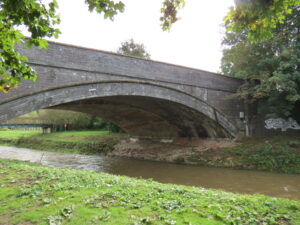
| Bridge Name: | Bathpool Bridge | |||
| No.: | 73 | |||
| Location: | Taunton – 51.02595,-3.07073 – Carries the A38 | |||
| Build Date: | circa 1836 | |||
| Engineer: | Brunel’s assistant, William Gravatt | |||
|
|
||||
| Description: | low-profile 22m span brick arch (24m on the skew) with grey sandstone facings and a a 7.6m span brick arch bridge over the towpath. Widened in 1930 and 2022 | |||
| Jervoise in The Ancient Bridges of the South of England, published in 1930 writes:
“Two miles below Taunton the road to Bridgwater crosses the Tone at a village called Bathpool. Although the present bridge is relatively modern, the Bathpool Mills certainly existed in the fourteenth century. They were the property of the Abbott of Glastonbury, and were rebuilt, if not originally founded, by Abbot Walter de Monyngton about the year 1634. An Exemplification of December 15th 1384, recited an Inquisition taken at Taunton ( 6 Richard II.), when the jurors presented that ” tyhe said Abbot of Glastonbury maintains in Monkton trees overhanging the Tone right across it so that boats cannot pass as they were wont between the mill of Tobrigge and Bathpool….also that the highway between Taunton and Bathepole brigge is undermined owing to a new mill he had erected close to Bathpoolmulle.” “.In 1623 a petition was put forward to the Quarter Sessions which stated ” a certain stone bridge called the farther Bathe Pool bridge is now in great decay and very dangerous”. In 1653 the sum of £40 was raised for its repair. The present bridge is built of brick and stone, and was widened in 1927.”1 Upon a petition from the inhabitants of West Munckton that a certain stone bridge called the farther Bathe Poole Bridge is now in great decay for want of reparations, and very dangerous ; being a great thoroughfare way, the greatest in those parts, and must be repaired speedily ; and for that it is unknown whether it should be repaired by the County or some particular parishes or private persons : Referred to Sir Henry Hawley and John Symes, Thomas Brereton, Robert Cuffe and George Browne, esquires, or to any four of them, to take some speedy course for the levying of monies for the repairing of the said bridge, and to certify at the next Sessions what they have done in and about the said work.2 When the B&ER was being built in the early 1840s the meander at Bathpool was bypassed by diverting the Tone into a new channel (the “New Cut”) alongside the railway line, thus eliminating the need for two railway bridges over the river. Brunel’s assistant, William Gravatt, designed three arches to carry the Bridgwater road on a skew angle over the river , the towpath and the railway. Over the New Cut there was a low-profile 22m span brick arch (24m on the skew) with grey sandstone facings; next there was a 7.6m span brick arch bridge over the towpath, followed by a 9m span brick arch bridge over the railway. New Cut Bridge and the Towpath Bridge were lengthened on the west side when the railway and road were widened in the 1930s, and a steel girder bridge has
|
||||
| References: | 1. The Ancient Bridges of the South of England – E.Jervoise – 1930 2. Quarter Sessions the 15th, 16th, 17th and 18th days of July, 21 James [1623], 3. Bridges Along the Tone – SCC Highways
|
|||